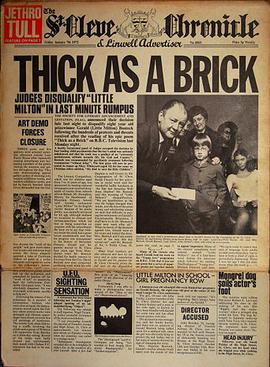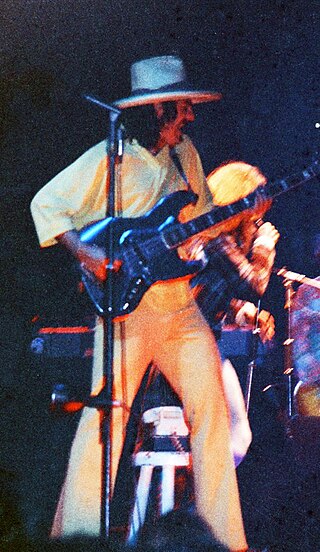
Jethro Tull are a British rock band formed in Luton, Bedfordshire, in 1967. Initially playing blues rock and jazz fusion, the band soon incorporated elements of English folk music, hard rock and classical music, forging a signature progressive rock sound. The group’s bandleader, founder, principal composer and only constant member is Ian Anderson, a multi-instrumentalist who mainly plays flute and acoustic guitar and is also the lead vocalist. The group has featured a succession of musicians throughout the decades, including significant contributors such as guitarists Mick Abrahams and Martin Barre ; keyboardists John Evan, Dee Palmer, Peter-John Vettese and Andrew Giddings; drummers Clive Bunker, Barrie "Barriemore" Barlow and Doane Perry; and bassists Glenn Cornick, Jeffrey Hammond, John Glascock, Dave Pegg and Jonathan Noyce.

Thick as a Brick is the fifth studio album by the British rock band Jethro Tull, released on 3 March 1972. The album contains one continuous piece of music, split over two sides of an LP record, and is intended as a parody of the concept album genre. The original packaging, designed as a 12-page newspaper, claims the album to be a musical adaptation of an epic poem by fictional eight-year-old genius Gerald Bostock, though the lyrics were actually written by the band's frontman, Ian Anderson.

Aqualung is the fourth studio album by the British rock band Jethro Tull, released on 19 March 1971, by Chrysalis Records. It is widely regarded as a concept album featuring a central theme of "the distinction between religion and God", though the band have said there was no intention to make a concept album, and that only a few songs have a unifying theme. Aqualung's success signalled a turning point in the career of the band, which went on to become a major radio and touring act.

Ian Scott Anderson is a Scottish musician best known for his work as the singer, flautist, acoustic guitarist, primary songwriter, and sole continuous member of the rock band Jethro Tull. He is a multi-instrumentalist who also plays harmonica, keyboards, bass guitar, bouzouki, balalaika, saxophone and a variety of whistles. His solo work began with Walk into Light in 1983; since then he has released another five albums, including the sequel to the 1972 Jethro Tull album Thick as a Brick, titled TaaB 2: Whatever Happened to Gerald Bostock? (2012).

Stand Up is the second studio album by British rock band Jethro Tull, released in 1969. It was the first Jethro Tull album to feature guitarist Martin Barre, who would go on to become the band's longtime guitarist until its initial dissolution in 2012. Before recording sessions for the album began, the band's original guitarist Mick Abrahams departed the band as a result of musical differences with frontman and primary songwriter Ian Anderson; Abrahams wanted to stay with the blues rock sound of their 1968 debut, This Was, while Anderson wished to add other musical influences such as folk rock.

Benefit is the third studio album by the British rock band Jethro Tull, released in April 1970. It was the first Tull album to include pianist and organist John Evan – though he was not yet considered a permanent member of the group – and the last to include bass guitarist Glenn Cornick, who was fired from the band upon completion of touring for the album. It was recorded at Morgan Studios, the same studio where the band recorded its previous album Stand Up; however, they experimented with more advanced recording techniques.

John Evan is a British musician and composer. He is best known as the keyboardist for Jethro Tull from April 1970 to June 1980.

Martin Lancelot Barre is an English guitarist best known for his longtime role as lead guitarist of British rock band Jethro Tull, with whom he recorded and toured from 1968 until the band's initial dissolution in 2011. Barre played on all of Jethro Tull's studio albums from their 1969 album Stand Up to their 2003 album The Jethro Tull Christmas Album. In the early 1990s he began a solo career, and he has recorded several albums as well as touring with his own live band.

Jeffrey Hammond, often known by his former stage name Jeffrey Hammond-Hammond, is an artist and retired musician best known for being the bassist of progressive rock band Jethro Tull from 1971 to 1975. With Jethro Tull, Hammond played on some of the band's most successful and well-known albums, including Aqualung (1971) and Thick as a Brick (1972).
"Aqualung" is a song by the British progressive rock band Jethro Tull, and the title track from their Aqualung (1971) album. The song was written by the band's frontman, Ian Anderson, and his then-wife Jennie Franks.

Clive William Bunker is a British drummer. Bunker is best known as the original drummer of the rock band Jethro Tull, playing in the band from 1967 until 1971. Never a self-professed technical drummer, Bunker engaged with the essence of blues and rock and roll, influenced by Ginger Baker and Mitch Mitchell. He was also inspired by Buddy Rich and The Hollies' Bobby Elliott.

"Locomotive Breath" is a song by British progressive rock band Jethro Tull from their 1971 album, Aqualung.
"Cross-Eyed Mary" is a song by the British progressive rock band Jethro Tull from their album Aqualung (1971).

Glenn Douglas Barnard Cornick was an English bass guitarist, best known as the original bassist for the British rock band Jethro Tull from 1967 to 1970. Rolling Stone has called his playing with Tull as "stout, nimble underpinning, the vital half of a blues-ribbed, jazz-fluent rhythm section".

Living in the Past is a double LP compilation album by Jethro Tull, released in 1972. It collects album tracks, outtakes and several standalone singles spanning the band's career up to that point. Also included are the 1971 "Life Is a Long Song" EP and two live recordings taken from a performance at New York City's Carnegie Hall in November 1970.
"Mother Goose" is a song by the British progressive rock band Jethro Tull. It is the fourth track from their album Aqualung which was released in 1971.

Live at Madison Square Garden 1978 is a concert video and an album by British rock band Jethro Tull, released in 2009. It was recorded on 9 October 1978 at Madison Square Garden in New York City.

Live at Montreux 2003 is a video and a live album by British rock band Jethro Tull, released in 2007. It was recorded at the Montreux Jazz Festival where the band played in 2003.
"Heavy Horses" is a song written by Ian Anderson and performed by his band Jethro Tull. The song was released on the 1978 album of the same name. Written as a tribute to horses, the song features folk rock elements that rebelled against the musical trends of the period.

"Teacher" is a song by the British rock band Jethro Tull, first released as the B-side to the January 1970 single "The Witch's Promise", on the Chrysalis label. Written by the band's frontman Ian Anderson, the song is a comment on the corruption of self-styled gurus who used their followers for their own gain.
















